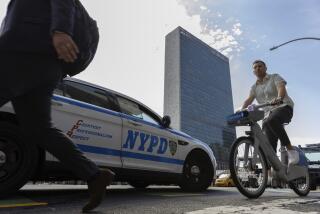Queen of Protocol Puts Leaders in Their Place
- Share via
UNITED NATIONS — With more than 150 world leaders gathered here under one roof this week, who is the most powerful person in the building?
Try Nadia Younes: She can tell President Clinton where to stand, President Vladimir V. Putin what to wear and Fidel Castro how long to speak.
Younes is the chief of protocol, the most diplomatic of the diplomats. The Egyptian-born official has been working at the United Nations for 30 years and was brought home from a stint in Kosovo to manage the largest gathering of presidents, potentates and pooh-bahs ever.
She is the one who puts the power into the power lunch by deciding the seating chart, and declares who gets to be in the front row of the commemorative picture.
“The beauty of this summit is that important meetings happen over sandwiches and in the hallways that could take a year to organize otherwise,” she said. “Everyone talks to each other. Even the warring countries.”
Younes greets each visiting dignitary, and knows when to bow, curtsy--or not to extend a hand to a leader forbidden by religious rules to touch women. But the leaders almost always settle for a simple handshake, she said.
Part of her job is to minimize friction between those who don’t want to sit next to each other at lunch, much less be seen in the same room. But despite her best efforts, accidents do happen. Cuba’s Castro approached Clinton after lunch in the crush of dignitaries, reached across four decades of enmity between their two nations and shook the U.S. president’s hand.
“Oh, did that happen?” she asked coyly, knowing that it is a matter of some embarrassment to the U.S. delegation, which denied for a while that it had even occurred. “All I can say is that I didn’t see it.”
And then the other part of her job is to orchestrate “chance” encounters between leaders who do want to meet one another, but need an excuse. “Some delegations will call and ask to be seated next to someone,” she admitted. But switching of place cards is absolutely not allowed.
There was a bit of horse trading, though, for speaking slots during the summit. During the three days, each leader gets five minutes to say his or her piece, with the order for each day’s session decided first by status and then by lottery: Heads of state go first, then crown princes or vice presidents, then ministers.
But Wednesday, Iranian President Mohammad Khatami was allowed to slip toward the head of the line so President Clinton could be present for his speech--a gesture of readiness to renew U.S.-Iranian ties broken since 1979.
And then there was Putin, Russia’s president. He wasn’t happy with his slot Wednesday afternoon. Leaders from the rest of the U.N. Security Council’s permanent members--the U.S., Britain, France and China--were speaking in the morning. So Putin asked the president of Cyprus, Glafcos Clerides, who had a desirable morning spot, to trade.
“The big boys were speaking in the morning, and naturally, he wanted to speak with the big boys,” Clerides said. He gave it up gladly, he said, because words flow “easier after a good lunch with a few drinks.”
Castro, known for his seven-hour speeches, threatened to ignore the five-minute limit--but finished in seven minutes.
The biggest worry of the summit was the commemorative photo. The permanent members of the Security Council (“the big boys”) got to be in the front row with U.N. Secretary-General Kofi Annan. The rest of the dignitaries were positioned in rows, again by status and then alphabetically--but definitely not by height. Diminutive Italian Prime Minister Giuliano Amato complained that he was almost blocked in the picture by a much taller Castro--revenge, he joked, for his years as a critic of the Cuban leader.
But if you look closely at the photo, meant to include only the top leader of each country, you will see two figures standing slightly behind their kings, messing up the row. “Interlopers,” U.N. spokesman Fred Eckhard jokes about the officials from Norway and Jordan. But Younes was, of course, more diplomatic. “Prime ministers,” she demurred. “You could say they also have a place there.”
Sometimes discretion is the better part of diplomacy. Though she could have, Younes didn’t tell British Prime Minister Tony Blair to fully button his coat for the picture, nor ask Putin to put one on when he was going around in his shirt sleeves at the summit.
“The U.N. is the house of the member states,” she said with a smile. “When they’re in their house, they can do what they want.”
More to Read
Sign up for Essential California
The most important California stories and recommendations in your inbox every morning.
You may occasionally receive promotional content from the Los Angeles Times.













